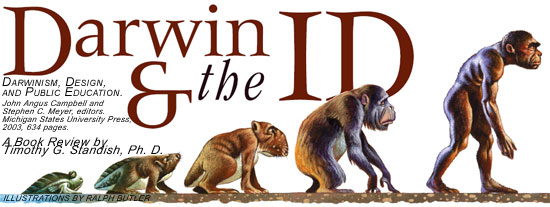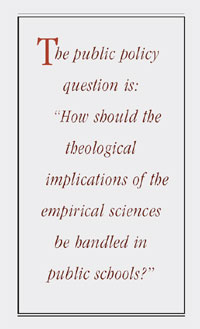Darwin And the ID
Timothy G. Standish March/April 2005
We've got people pushing and shoving to be the plaintiff on this," announced Case Western Reserve University philosophy professor Patricia Princehouse in a recent issue of Science.1 She was not talking about another secondhand smoke lawsuit or grab for the deep corporate pockets of a hot-coffee-serving fast-food restaurateur. No, Professor Princehouse is threatening legal fire and brimstone on the state of Ohio because of a single lesson plan questioning Darwinism buried deep inside a 558-page model curriculum published by the Ohio Department of Education.2
When it comes to public policy hot potatoes, teaching evolution in public schools is up there with abortion, taxes, and civil rights. And why shouldn't it be? Teaching Darwinian evolution to impressionable children at taxpayers' expense represents an explosive nexus of political and religious interests.
Observant readers will immediately ask why scientific interests are not included in this nexus. Maybe they should be, but the debate about how life and the physical universe originated has always centered around theological—yes, atheism is just as theological as any other theism—and political concerns. Science may inform questions about origins, but the engine that keeps the debate rolling is ultimately theology. Theologies that can't survive in an open marketplace of ideas may resort to derailing the quest for truth by political means.

Campbell, professor of communication at the University of Memphis, and Meyer, with a Ph.D. in the history and philosophy of science from Cambridge University, are clearly not fools. Thus, entering the fray having already publicly embraced the greatest current heresy challenging the Darwinian orthodoxy—intelligent design (ID) theory—must have plumbed the depths of their courage.
Few ideas have generated such a hysterical response as ID among otherwise rational people. Recently Marshal Berman, past vice president of the New Mexico State Board of Education, among many other titles, warned America's biology teachers that ID advocates "are jeopardizing the nature of science itself, our education system, and even our form of government." Whipping up his audience further, he calls on "those who cherish our republic and freedom to take a strong stand against those who would prefer a theocracy, not in Iran or Afghanistan, but here in the United States."3 One would almost think that it is time for biology teachers to abandon their chalkboards and take up assault rifles together with the New Mexico Constitutional Militia!
In the face of such hysteria Darwinism, Design, and Public Education presents a valuable resource on scientific and public policy issues raised by ID. Unlike the majority of books championing either ID or Darwinism, diversity of opinion is embraced in this book. The ID case is presented with some verve and detail. But "Critical Responses," the fourth and final section in this book, is dedicated almost entirely to critics of ID. These critics constitute a sampling of well-known academics, including Bruce Webber, professor emeritus of biochemistry at California State University Fullerton, and Michael Ruse, Lucyle T. Werkmeister Professor of Philosophy at Florida State University. Across the board, the 30 authors who contributed to this 600-plus page volume, whether they support opening science classrooms to ID or not, represent an impressive collection of academics.
The question of design in nature represents the spot where the rubber hits the road for atheism. Those religions that believe in a personal God who acts in the empirical world cannot survive if no evidence of their God's action is evident in nature. They have made a claim—a testable hypothesis, in the idiom of science—that can be empirically tested. The fingerprints of God are not required to be everywhere, but they should be somewhere. If nature appears to be the result, at least in part, of intelligent causes—if ID is real—this prima facie evidence of God's action in nature would reasonably infer the existence of God.
This line of reasoning has traditionally been called the "argument from design," and features in the writings of thinkers ranging from Plato and Aristotle, to the apostle Paul, to William Paley in the eighteenth century. These great thinkers did not make their arguments in a vacuum. The Epicurean philosophers that Paul debated on Mars' Hill in Athens4 did not believe gods played a role in the material world. About 55 B.C., Titus Lucretius Carus, a popularizer of Epicureanism, even outlined what looks very much like the modern theory of chemical evolution, starting with random interactions of atoms and leading ultimately to living things.5 Lucretius, along with other Epicureans, argued against design, stating, "Nature can be seen to be free of overlords, everything she does is completely by herself, without help from gods."6
Use of empirical reality to support or oppose one or another theological view has a long and storied history. The public policy question is: "How should the theological implications of the empirical sciences be handled in public schools?" The specific question being addressed in Darwinism, Design, and Public Education is: "Given that the Constitution does not preclude teaching students the truth, what should be done with the apparent design in nature, especially in biology?" Charles Darwin and modern neo-Darwinists argue that the apparent design can be accounted for by the "natural" mechanism of chance genetic mutations coupled with natural selection. Darwinism removes the necessity of intelligent causes in nature, and thus the hyper-Darwinist Richard Dawkins triumphally states, "Darwin made it possible to be an intellectually fulfilled atheist."7
Darwinism is not theologically impartial—minimally, it removes God as an immediate cause for species—and yet courts have ruled as if it is somehow religiously neutral. In contrast, creationism has been treated as a religious doctrine by the courts, and thus, invoking the need for religious neutrality enshrined in the First Amendment, the courts have banished creationism from state-sponsored education. ID undercuts this line of reasoning by asserting two things and carefully avoiding a third assertion. First, ID flatly denies the adequacy of neo-Darwinism to explain at least some examples of design in nature. For example, in his chapter in Darwinism, Design, and Public Education, Michael Behe gives a brief version of his argument that certain machinelike protein complexes are irreducibly complex. Protein complexes of the type singled out by Behe must have come into being via a single large step rather than "numerous successive, slight modifications." This appears to fulfill Darwin's observation that "if it could be demonstrated that any complex organ existed, which could not possibly have been formed by numerous, successive, slight modifications, my theory would absolutely break down."8

The assertion studiously avoided by advocates of ID is that the intelligent designer logically inferred from nature is or must be God. Clearly this is viewed as the Achilles' heel of ID by its opponents, the vast majority of whom invoke its religious implications as a major objection to its status as science and its place in public schools. For example, Massimo Pigliucci invokes the terms "creationism," "neo-creationists," "Christian," "Bible" and "neo-creationism" in the three-sentence opening paragraph of one chapter he contributed to this book (see pp. 463-473). A chapter by Phillip Johnson, considered by many to be the father of the ID movement, states the obvious when he observes that "the greatest hurdle faced by the intelligent design (ID) movement is to overcome the prejudice that says that to attribute anything in biology to a Designer is to engage in 'religion' rather than 'science'" (see pp. 549-554). This clearly is a challenge, whether it is logical or not. However, arguments similar to this immaterial "creationist" scare-mongering have been used against well-accepted ideas in the sciences. For example, that the big bang is somehow sympathetic to theism was used as an objection to big bang cosmology.9
Blessed with the rhetorical advantage of having the final word, critics of ID respond disappointingly in Darwinism, Design, and Public Education. In fact, the lack of engagement by opponents of ID is baffling. ID proponents address the objections of their opponents, but those arguing against ID use the same objections as if they had never been addressed. Bruce Webber, for example, accuses Behe of virtually ignoring "current research on self-organizing, emergent phenomena" (see pp. 455-462).
Self-organization is not addressed by Behe in this book, but it is addressed by Meyer et al. (see pp. 323-402) and Meyer(see pp. 223-285). David Depew (see pp. 441-454) invokes a demarcation argument, defining science in such a way that it excludes ID, but DeWolf et al. (see pp. 59-132) and Campbell (see pp. 3-44) document the abandonment of demarcation arguments by philosophers of science. Massimo Pigliucci (see pp. 463-473) invokes gene duplication, the problems of which are pointed out by Meyer et al. Pigliucci takes things up a notch, declaring that organisms "are full of junk, nonutilized or underutilized parts" (see p. 470). This vacuous "vestigial organs" argument is addressed by Mills et al. (see pp. 207-219). Responses to pro-ID essays are rife with question-begging and straw-man arguments that never seek to address the issues raised. It is almost as if invoking "creationism" will in abracadabra-like fashion magically zap all opposition to Darwinism. Presto-poof, and away blows the opposition in a puff of smoke, leaving only lithe and lovely Darwinism clad, as it turns out, very scantily.
Michael Ruse's chapter explaining his testimony in McLean v. Arkansas Board of Education, the Arkansas creation-science case,10 is enlightening, disturbing, and deserving of special mention. His disclosure is important, because Judge William Overton's rationale in deciding the case derived directly from Ruse's testimony.
Unfortunately, his testimony as an expert witness in the trial does not reflect current thinking, or apparently his own thinking at the time (see pp. 3-44). So how does Ruse justify his fallacious testimony? With a disturbing and shameful admission that he had "Creationism of the ilk to be found in John Whitcomb and Henry Morris's Genesis Flood . . . in my sights in Arkansas." In other words, the objective of discrediting one kind of creationism justified tainting his testimony. Although many are honest, some involved in debating these issues are unconstrained by facts, truth, or logic.
In the strange world of public policy, good thinking does not always triumph. Darwinism, Design, and Public Education provides the best resource yet for those who are interested in seeing that it does.
That opponents of ID would feel so unconstrained by facts or good arguments is embarrassingly exposed. On the ID side, the best current arguments are presented and seem to be sound. Darwinism, Design, and Public Education illustrates the value of its
central argument, that the controversy over evolu-tionary theory should be taught in public school science classes, not the current clumsy version of neo-Darwinian dogma. This controversy makes for fascinating reading. The strengths and weaknesses of each side are laid bare, and when both sides are allowed to make their case, one turns out to be barer than the other. If nothing else, this book serves the function of the little boy stating that the king—in this case Darwinism—has no clothes.
________________________
Timothy Standish is a research scientist at the Geoscience Research Institute, Loma Linda, California.
________________________
1 C. Holden, ed., "Disappointing News From Ohio in Random Samples," Science 303 (2004):1761.
2 http://www.ode.state.oh.us/academic_content_standards/sciencesboe/scisboe_contents.asp.
3 Marshall Berman, "Intelligent Design Creationism: A Threat to Society: Not Just Biology," American Biology Teacher 65, no. 9 (2003): 646-648.
4 Acts 17:18-32.
5 Titus Lucretius Carus, De Rerum Natura (circa 55 B.C.), book 5, lines 416-431.
6 My own translation from the same source as above. Book 2, lines 190-192:
190 Natura videtur
191 Libera continuo, dominis privata superbis,
192 ipsa sua per se sponte omnia dis agere espers.
7 Richard Dawkins, The Blind Watchmaker: Why the Evidence of Evolution Reveals a Universe Without Design (New York: W. W. Norton and Company, 1986), p. 6.
8 Charles Darwin, The Origin of Species by Means of Natural Selection or the Preservation of Favoured Races in the Struggle for Life (New York: Penguin Books, 1958 edition), p. 171.
9 S. W. Hawking, A Brief History of Time: From the Big Bang to Black Holes (Toronto: Bantum, 1988), pp. 46, 47.
10 www.antievolution.org/projects/mclean/new_site/index.htm#McLean
%20v.%20Arkansas%20decision.